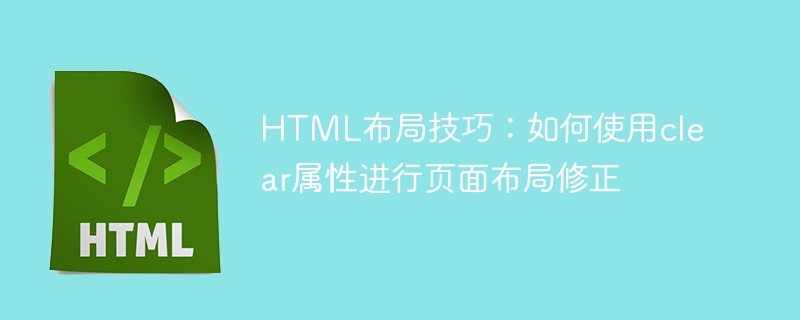Home >Web Front-end >HTML Tutorial >HTML layout tips: How to use the clear attribute to modify page layout
HTML layout tips: How to use the clear attribute to modify page layout
- WBOYWBOYWBOYWBOYWBOYWBOYWBOYWBOYWBOYWBOYWBOYWBOYWBOriginal
- 2023-10-20 08:42:371256browse

HTML Layout Tips: How to Use the Clear Attribute for Page Layout Correction
During web development, layout problems are often encountered, especially when using floating elements. . After floating elements are separated from the document flow, they may cause the height of the parent element to collapse, thus affecting the entire page layout. In order to solve this problem, we can use the clear attribute to make layout corrections.
The common way to clear floats is to use the clear attribute. Commonly used values are none, left, right and both.
- clear: none: Indicates that floating elements can exist on both left and right sides of the element;
- clear: left: Indicates that floating elements are not allowed on the left side of the element;
- clear: right: Indicates that floating elements are not allowed on the right side of the element;
- clear: both: Indicates that floating elements are not allowed on the left and right sides of the element.
Below we use several specific code examples to demonstrate how to use the clear attribute to modify the page layout.
Example 1: Layout correction after clearing floats
<style>
.container {
border: 1px solid #000;
overflow: hidden; /* 清除浮动 */
}
.left {
width: 200px;
height: 200px;
float: left;
background-color: red;
}
.right {
width: 200px;
height: 200px;
float: right;
background-color: blue;
}
</style>
<div class="container">
<div class="left"></div>
<div class="right"></div>
</div>In the above code, we use a container container to wrap two floating elements left and right. Due to the presence of floating elements, the height of the container collapses, causing the border to not display properly. In order to correct this problem, we added the overflow: hidden; attribute to .container. By setting the overflow attribute to hidden, the container can contain floating elements, thereby correcting the layout problem.
Example 2: Correction of top and bottom spacing after clearing floats
<style>
.box {
width: 200px;
height: 200px;
float: left;
background-color: red;
margin-bottom: 20px;
}
.clear {
clear: both;
}
</style>
<div class="box"></div>
<div class="box"></div>
<div class="box"></div>
<div class="clear"></div>In the above code, we have three floating elements.box, and the top and bottom spacing between each element is 20px. If left untreated, the spacing between them will collapse. To solve this problem, we added an empty div after the last .box and set its clear attribute to both. By setting the clear attribute to both, we can ensure that the elements after this element are not affected by the floating elements, thus correcting the layout problem of top and bottom spacing.
Using the clear attribute can easily correct layout problems on the page, but excessive use will add meaningless html elements. Therefore, in actual development, we should minimize the use of the clear attribute and pay attention to optimizing the layout structure to avoid layout problems.
Summary: Use the clear attribute to easily correct layout problems caused by floating elements. By setting the clear attribute to none, left, right, or both, we can limit the presence of floating elements around the element to achieve page layout modifications. In actual development, we should make reasonable choices based on specific layout issues, pay attention to optimizing the layout structure, and reduce the number of times the clear attribute is used.
The above is the detailed content of HTML layout tips: How to use the clear attribute to modify page layout. For more information, please follow other related articles on the PHP Chinese website!

